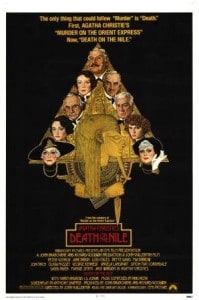“Do not allow evil into your heart, it will make a home there.” —Hercule Poirot
It is easy to write about the 1978 screen version of Agatha Christie’s Death on the Nile. The obvious, summarizing comment is that it isn’t as good as Murder on the Orient Express, made four years earlier—not a great film itself, but, at the time, the largest British movie money-maker, ever. Murder is superior in every detail and aspect regarding production, acting, script and score; even the all-star level, with perhaps a deliberate avoidance of duplicate big-name appearances, is noticeably less brilliant.
Superior except—— Where Death on the Nile does excel is in the scenery, spectacular indeed, shot by Jack Cardiff, one of the great color cinematographers (The Red Shoes, The African Queen and his one Oscar win, Black Narcissus). The Nile company spent seven weeks on location in Egypt, with plot excursions to Cairo, Aswan, Luxor and Abu Simbel—scenery galore. Four weeks were spent filming at Pinewood studios, England, aboard a mock-up of the actual Nile paddle steamer Memnon, renamed Karnak, that was used in location filming. Karnak is also the name of the Egyptian temple where occurs one of two failed murder attempts.
John Brabourne, who had produced Murder on the Orient Express, as well as Sink the Bismarck!, A Passage to India and other theatrical films, wanted to assemble another mega-hit, and a second Christie mystery. The premise would be the same—a star-studded cast, beautiful scenery and a journey aboard a confining conveyance from which suspects and murderers alike could not escape. Brabourne would later produce two more Christie films—The Mirror Crack’d and Evil Under the Sun.
 Death on the Nile was directed by another Englishman named John, John Guillermin whose few other good films include The Blue Max and The Bridge at Remagen. Guillermin must also take blame for the disastrous 1976 remake of King Kong, though it did feature Jessica Lange’s screen début.
Death on the Nile was directed by another Englishman named John, John Guillermin whose few other good films include The Blue Max and The Bridge at Remagen. Guillermin must also take blame for the disastrous 1976 remake of King Kong, though it did feature Jessica Lange’s screen début.
As in the long train ride in Murder on the Orient Express, a similar device in Nile is another group of people on another journey, a steamboat tour of Egypt. The solution as to whodunit—perhaps another plus for Nile—is harder to figure out, impossible, in fact, if left strictly to logic. Playing detective Hercule Poirot this time around, the first of his six appearances in lesser film follow-ups, is the erudite Peter Ustinov, erudite in the part as in real life. He gives less attention to Poirot’s hair and mustache fetish, the styling, waxing and bedtime nets, than does the more persnickety Albert Finney in Murder.
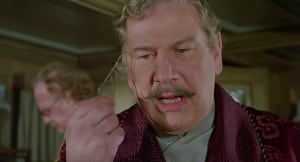 Making convincing Poirot’s fastidiousness in dress and manner was a problem for Ustinov. “Since he is essentially immaculate in his person at all times,” Ustinov commented, “and I lean toward untidiness, creased garments and a general lack of sartorial elegance with no effort whatsoever, there were certain major differences between us that needed to be reckoned with.”
Making convincing Poirot’s fastidiousness in dress and manner was a problem for Ustinov. “Since he is essentially immaculate in his person at all times,” Ustinov commented, “and I lean toward untidiness, creased garments and a general lack of sartorial elegance with no effort whatsoever, there were certain major differences between us that needed to be reckoned with.”
From the mind and pen of his creator, Poirot made his initial appearance in 1920 in The Mysterious Affair at Styles, Agatha Christie’s first published novel. Captain Hastings, his sidekick in a quarter of the Poirot adventures, describes the detective—surely as Christie saw him—as “ . . . an extraordinary little man. He was hardly more than five feet, four inches, but carried himself with great dignity. His head was exactly the shape of an egg, and he always perched it a little on one side. His moustache was very stiff and military. The neatness of his attire was almost incredible. I believe a speck of dust would have caused him more pain than a bullet wound.”
Speaking of Hastings, and forgive this and other asides, there is a curious case of similarities here—an author borrowing from another author—although Christie made a determined effort to avoid any resemblance between her Belgian sleuth and that earlier and most famous of fictional detectives, Sir Arthur Conan Doyle’s Sherlock Holmes. Most detectives, it seems, have partners and Poirot had a number of them, Captain Hastings being the first. Hastings, who serves as the narrator in Styles, was recovering at the time from wounds suffered at the front during World War I. Now, Dr. John Watson, the sidekick of Holmes, had himself received a wound—a bullet in the shoulder during the Battle of Maiwand in the Second Anglo-Afghan War (1878-1880). Coincidence or a borrowing?—
The history of Poirot on screen is perhaps less varied than that of Miss Marple, Christie’s second most famous detective. It is interesting to see how close those actors who have played the Belgian sleuth come to any ideal image, or to W. Smithson Broadhead’s 1924 dust cover sketch of him for the short story collection Poirot Investigates. A preference for any one actor is left to the individual tastes and preferences of Poirot followers, all of whom, be assured, are conversant on the choices available and passionate about their favorite.
 Austin Trevor was the first actor to portray him on screen, in Alibi (1931), based on what many Christie scholars consider the best of all her detective stories, The Murder of Roger Ackroyd. Trevor was reprising the stage role created by Charles Laughton, technically the first actor, in any medium, to appear as Poirot. Others followed in theaters and on television, some “Christie serious,” others strictly comical, including Tony Randall (The Alphabet Murders), James Coco (Murder by Death), Ian Holm (Murder by the Book) and Alfred Molina (the Murder on the Orient Express of 2001). Then there is, of course, Peter Ustinov, who has the second most screen appearances, after—
Austin Trevor was the first actor to portray him on screen, in Alibi (1931), based on what many Christie scholars consider the best of all her detective stories, The Murder of Roger Ackroyd. Trevor was reprising the stage role created by Charles Laughton, technically the first actor, in any medium, to appear as Poirot. Others followed in theaters and on television, some “Christie serious,” others strictly comical, including Tony Randall (The Alphabet Murders), James Coco (Murder by Death), Ian Holm (Murder by the Book) and Alfred Molina (the Murder on the Orient Express of 2001). Then there is, of course, Peter Ustinov, who has the second most screen appearances, after—
Also a London-born actor, David Suchet did some seventy television episodes, 1989-2013, for British television, clearly taking the trophy for the most appearances. Suchet seems to combine all facets of the Broadhead illustration—the egg-shaped face, the conspicuous stomach, the upward-curved black mustache, the slicked down hair, the glasses (worn only occasionally, as the lenses reflected too easily in the camera), but also the gloves, the white spats and the cane, though, yes, a bowler instead of the silk top hat. Suchet, out of his own imagination, seems to have added the prissy walk, those dainty mini-steps.
As for the character and personality of Poirot, Suchet concentrates with equal emphasis on his character’s deft command of those “little gray cells,” the colossal ego, that hygienic neatness, the often misquoting of English sayings (“the side of the bed manner”), the love of the good life, a preference for chocolate and liquor through a straw, the delight in deriding other people’s eccentricities and so many, many other qualities.
(As of this writing, Suchet has already closed his career as Poirot, having appeared on British TV in November in the final episode of the series, Curtain, to be available in the U.S. later in 2014. Written in the early 1940s, the Curtain manuscript was locked away in a bank vault until Christie felt the time right for publication, 1975 as it turned out, a year before her death. In the mystery, Poirot, suffering from heart disease and arthritis, is reunited with Captain Hastings at the site of his first case, Styles Court, where he dies. “They were good days,” he says. “Yes, they have been good days.”)
 And Ustinov’s approach to Poirot? Much more low-key, laid-back at times, almost a walk-through on the actor’s part. Unruffled. Never uptight, rarely judgmental of his companions and, if so, the criticisms are politely dispensed. He adds perhaps the one feature Suchet’s portrayal most obviously lacks, unless in the guise of sarcasm—a sense of humor; even this, though, is delivered with a straight face, as if he were an impassive outsider viewing his ingenuity, yet, at the same time, subtly acknowledging an awareness of his underlying haughtiness.
And Ustinov’s approach to Poirot? Much more low-key, laid-back at times, almost a walk-through on the actor’s part. Unruffled. Never uptight, rarely judgmental of his companions and, if so, the criticisms are politely dispensed. He adds perhaps the one feature Suchet’s portrayal most obviously lacks, unless in the guise of sarcasm—a sense of humor; even this, though, is delivered with a straight face, as if he were an impassive outsider viewing his ingenuity, yet, at the same time, subtly acknowledging an awareness of his underlying haughtiness.
The running joke in most Poirot film adaptations is people mistaking Poirot for a Frenchman. He is forever correcting them. When one of the suspects in the Nile movie calls him a “damn froggy eavesdropper,” Poirot corrects him: “Belgian! Belgian eavesdropper!” As for Suchet’s effeminate walk? Nothing doing: Ustinov will have none of that!
In Death on the Nile, everyone, it seems, has a motive for killing wealthy Linnet Ridgeway (Lois Chiles), who is found in her steamer cabin, shot in the head.
Foremost among the suspects, and clearly implied in the script, there is Jacqueline de Bellefort (Mia Farrow), who, early on, has a heated shipboard argument with her former fiancé Simon Doyle (Simon MacCorkindale), shooting him in the leg. After Simon had married her friend Linnet, the jilted Jackie has been harassing the newly weds, even haunting them in the midst of a romantic tryst on one of the smaller pyramids near the Great Pyramids of Giza and appearing atop one of the statues of the Abu Simbel temples.
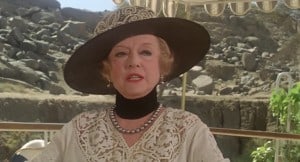 And the other suspects? Providing some of the best barbed repartee in the film, there are those two old-lady antagonists, Mrs. Van Schuyler (Bette Davis), whose motive for the murder might be Linnet’s jewels, and her traveling companion Miss Bowers (Maggie Smith), who has lost her wealth when Linnet’s father decimated her family.
And the other suspects? Providing some of the best barbed repartee in the film, there are those two old-lady antagonists, Mrs. Van Schuyler (Bette Davis), whose motive for the murder might be Linnet’s jewels, and her traveling companion Miss Bowers (Maggie Smith), who has lost her wealth when Linnet’s father decimated her family.
The true character in the group, as eccentric as Suchet were he doing his Poirot this time around, is romance writer Salome Otterbourne (played over the top, and to good effect, by Angela Lansbury), who faces a libel suit brought by Linnet. Her daughter Rosalie (Olivia Hussey) simply desires to shield her mother from any bad publicity.
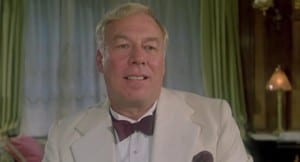 And there are other possible murderers: embezzling lawyer (George Kennedy), disgruntled Swiss psychiatrist (Jack Warden), unhappy maid (Jane Birkin) and devoted Communist (Jon Finch)—this in the order of attention given to them in the script. Quite a list, and considerably fewer suspects than in the novel, what with Christie’s proclivity for “a cast of thousands” among her possible villains.
And there are other possible murderers: embezzling lawyer (George Kennedy), disgruntled Swiss psychiatrist (Jack Warden), unhappy maid (Jane Birkin) and devoted Communist (Jon Finch)—this in the order of attention given to them in the script. Quite a list, and considerably fewer suspects than in the novel, what with Christie’s proclivity for “a cast of thousands” among her possible villains.
The only remaining big star among this all-star cast is David Niven as ex-army man Colonel Race—not a suspect but a Poirot friend. (Wouldn’t it be a super twist of plot if he were the murderer?!) Much like other sidekicks of the great detective, including Captain Hastings and Chief Inspector Japp, Race appears in a number of Christie mysteries; besides Nile, he lends assistance in Cards on the Table,Sparkling Cyanide and The Man in the Brown Suit.
 The stars, a fair balance between British and American (Hussey was born in Argentina), are perhaps less uniformly good than those in Murder. The easy standouts are Ustinov and Lansbury. Farrow is a little over the top, not in a positive way as with Lansbury, the required script hysteria being just too hysterical at times, often becoming inflated. At the time, Farrow was a few years away from A Midsummer Night’s Sex Comedy, the first of her thirteen films with Woody Allen.
The stars, a fair balance between British and American (Hussey was born in Argentina), are perhaps less uniformly good than those in Murder. The easy standouts are Ustinov and Lansbury. Farrow is a little over the top, not in a positive way as with Lansbury, the required script hysteria being just too hysterical at times, often becoming inflated. At the time, Farrow was a few years away from A Midsummer Night’s Sex Comedy, the first of her thirteen films with Woody Allen.
Davis and Smith, as already mentioned, are endearing bitches, with nothing good to say about one another; Davis, by this time, was well into her nasty role period and here does them, and herself, justice. As for some of the other stars, MacCorkindale plays his part well as Simon, Niven is charming as Poirot’s shadow and Warden handles his German accent passably, though Kennedy doesn’t often rise above what-you-see-is-what-you-get and Finch, a small part anyway, dissolves into the wallboard. Look quickly for the always noteworthy Harry Andrews, who made the best of the many small parts during his career, though here he hardly has a chance as a house servant in the opening scene.
Of course, as in any number of Christie mysteries, the execution and complexities of these Nile murders—no big secret, there are three “official” ones—are so far-fetched and impracticable as to be laughable. There is, of course, the bonus murder/suicide/twist ending. Shhh-h-h— No more about that. The unrealistic aspects are written into the scheme(s), not that Christie had run upon some unforeseen “problem,” since the lady author was comfortable with this manner of writing, established in countless other mysteries.
First of all, be warned and a clue: the event surrounding the first gun fired in anger is not what it appears to be, so it’s unlikely most first-time viewers, and those who have not read the book, will deduce the solution. In this case, because the first murder requires a lot of running around the outer deck of the steamer while “the others” are preoccupied, there is the possibility that he, or she, might be seen. Sure enough, seen indeed, requiring the second murder. Then, once again—an uninspired plot repetition!—that second murder is also witnessed during another running about the deck, requiring—— That’s right!
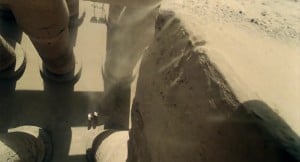 Then there is that earlier mentioned failed murder attempt, that is, an unseen somebody pushing a two-ton stone block off the top of one of the columns of the Temple of Karnak. Not only is such a feat impossible, it seems highly improbable that a tourist would be allowed on, or could even gain access to, that lofty height. Still more crucial, the act is illogical and risky, since of the two people standing together below, only one is the intended victim.
Then there is that earlier mentioned failed murder attempt, that is, an unseen somebody pushing a two-ton stone block off the top of one of the columns of the Temple of Karnak. Not only is such a feat impossible, it seems highly improbable that a tourist would be allowed on, or could even gain access to, that lofty height. Still more crucial, the act is illogical and risky, since of the two people standing together below, only one is the intended victim.
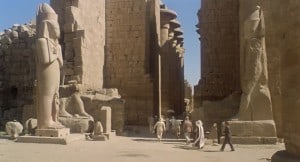 The photography and music of the scene, however, is quite effective, one of the suspense highlights of the film. All the suspects have disembarked from the steamer and are strolling, in pairs or alone, through the temple, moving around the bases of these massive columns. At first, as the camera roams among the columns, sometimes shooting from overhead, sometimes panning up a pillar, Nino Rota’s score is quietly, hesitantly quoting the main theme. Then the music evaporates and only the sound of birds is left, otherwise—silence. For the longest time this continues, the tourists appearing and disappearing among the columns, the cliché of “deafening silence” indicative that something is about to happen. . . .
The photography and music of the scene, however, is quite effective, one of the suspense highlights of the film. All the suspects have disembarked from the steamer and are strolling, in pairs or alone, through the temple, moving around the bases of these massive columns. At first, as the camera roams among the columns, sometimes shooting from overhead, sometimes panning up a pillar, Nino Rota’s score is quietly, hesitantly quoting the main theme. Then the music evaporates and only the sound of birds is left, otherwise—silence. For the longest time this continues, the tourists appearing and disappearing among the columns, the cliché of “deafening silence” indicative that something is about to happen. . . .
A hand-held camera simulates the viewpoint of someone breathing heavily and running up some dark, narrow back steps. After a brief return to the tense tranquility of the tourists strolling about, the stone is pushed slowly toward the edge of the one column, disturbed sand drifting down in the wind. The stone crashes near the couple, who are thrown to the floor of the temple. They are unhurt, but Poirot exclaims the obvious: “Accident?! That stone has been up there for four thousand years. It chooses the moment to fall when there are people underneath it? . . . No!”
Come to think of it, Poirot is also the target of another murder attempt from a strategically placed cobra in his bathroom. Captain Race comes to the rescue.
 Returning to Murder on the Orient Express for one last reference, Richard Rodney Bennett’s music is really two scores in one, the juxtaposition of two drastically different sounds: the one that accompanies the passengers on their train journey is lively, romantic and 1930’s-ish, all splash and glitter, including a waltz; the other music style that represents the long flashback kidnapping of infant Daisy Armstrong and, later, the murder of the dastardly Ratchett is dark and semi-dissonant. The score justly received an Oscar nomination.
Returning to Murder on the Orient Express for one last reference, Richard Rodney Bennett’s music is really two scores in one, the juxtaposition of two drastically different sounds: the one that accompanies the passengers on their train journey is lively, romantic and 1930’s-ish, all splash and glitter, including a waltz; the other music style that represents the long flashback kidnapping of infant Daisy Armstrong and, later, the murder of the dastardly Ratchett is dark and semi-dissonant. The score justly received an Oscar nomination.
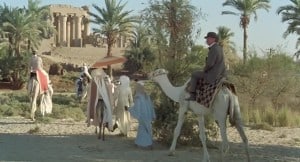 No nomination for Rota’s score for Nile, music which is effective, doing good service, but nothing spectacular. The main theme, with that “dropped” note on the end, may remind some ears of Erich Wolfgang Korngold’s Another Dawn (1937), more specifically the tune he later used in his Violin Concerto in D. Rota’s music for the steamboat is given an aptly lethargic rhythm and the supposed “swish” of water. More lively music, with an impish piccolo and muted, mocking trumpets, accompanies the tourists as they mount camels and donkeys and trek to the Temple of Karnak. And the love theme in most affecting in the solo oboe, an instrument that has a special and frequent place in the music. (The only Oscar nomination/win for Nile was for Anthony Powell’s costume design.)
No nomination for Rota’s score for Nile, music which is effective, doing good service, but nothing spectacular. The main theme, with that “dropped” note on the end, may remind some ears of Erich Wolfgang Korngold’s Another Dawn (1937), more specifically the tune he later used in his Violin Concerto in D. Rota’s music for the steamboat is given an aptly lethargic rhythm and the supposed “swish” of water. More lively music, with an impish piccolo and muted, mocking trumpets, accompanies the tourists as they mount camels and donkeys and trek to the Temple of Karnak. And the love theme in most affecting in the solo oboe, an instrument that has a special and frequent place in the music. (The only Oscar nomination/win for Nile was for Anthony Powell’s costume design.)
As occurs in Murder, Rota incorporates in Nile source music, popular tunes of the day: Nacio Brown’s “I’ve Got a Feelin’ You’re Foolin’,” Harry Warren’s “I Love My Baby (My Baby Loves Me)” and Jacob Gade’s “Jalousie.” Jackie even sings the three-composer song, “Frankie and Johnny,” drawing something of a parallel between herself and Simon.
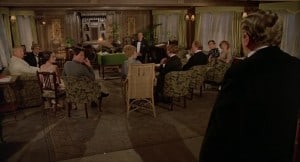 Poirot’s dénouement at the end of Death on the Nile, with all the suspects assembled before him, is standard procedure in Poirot and Marple mysteries. On screen, flashbacks reveal the chain of events and how the murders were committed. Here, Ustinov is less dramatic, with fewer histrionics, than Finney in Murder.
Poirot’s dénouement at the end of Death on the Nile, with all the suspects assembled before him, is standard procedure in Poirot and Marple mysteries. On screen, flashbacks reveal the chain of events and how the murders were committed. Here, Ustinov is less dramatic, with fewer histrionics, than Finney in Murder.
As in so many murder mysteries, not just by Christie but other writers, in movies and television, the question is always, How can these detectives continue on their police forces or retain the esteem of the public when bodies keep piling up, murders going unsolved for the duration of an entire novel or movie?!
